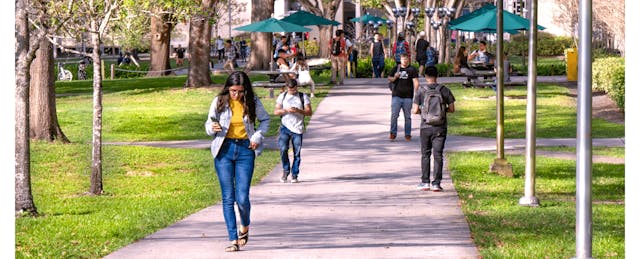The national consensus supporting higher education is unraveling, as backing for college funding is increasingly becoming a partisan issue. And that's having a disproportionate impact on poor and historically underserved students.
College enrollment is down nationwide, from about 17 million in 2020 to 15.9 million in the latest data from the National Student Clearinghouse Research Center—a big historical change.
“With the exception of wartime, the United States has never been through a period of declining educational attainment like this,” says Michael Hicks, director of the Center for Business and Economic Research at Ball State University.
But not all types of students are opting out of college. The steepest declines are at public two-year and four-year institutions, the more-affordable options that serve larger percentages of poor, working-class and minority students. Meanwhile, elite colleges that serve wealthier families are actually seeing a boost. The nation’s most-selective four-year colleges this year experienced a record 17 percent increase in applications.
Compared to last spring, the NSCRC report also revealed a 6.5 percent decline in Black freshman. Black students were the only segment this spring that declined among first-time freshmen. Enrollment in areas with large low-income and minority populations fell most sharply, notes Carleton College economics professor Nathan D. Grawe.
There are plenty of complaints about the high cost of tuition, and it can feel like it’s always been that way. But looking at historical trends reveals steady rises in state college tuition, going back to when I graduated from Brooklyn College in the early sixes—when my classmates and I paid no tuition.
Defunding Higher Education
Tuition at four-year state schools from the 1960s to the ‘80s stayed pretty flat, reflecting a national narrative that college is not only good for forming smart, well-informed citizens, but also for building a prosperous economy. In those years, the public supported higher ed equally for both its private and public benefits—on the whole, we were a nation that honored higher education.
But since then, many conservative state legislators, spurred on by right-wing critics of higher education, have succeeded in decimating state funding, resulting in tuition skyrocketing—making it tough for families with limited income to afford college. Such cuts have accelerated racial and class inequality.
The campaign to defund state universities was launched in earnest in the1960s, when California Governor Ronald Reagan severely slashed the state’s higher ed budget, moving from generous public support to relying on limited student family resources, a move that started the nationwide shift in American higher ed. Today at state 4-year institutions students now must cover nearly half of higher ed costs.
About 50 years ago, libertarian Nobel laureate James M. Buchanan collaborated with billionaire Charles Koch in massive efforts, financed by Koch’s many deep-pocketed foundations, to encourage state legislatures to withdraw public funds from higher ed.
Recently released tax records show that in 2019, Koch’s campaign totaled more than $112 million, far outspending its common annual stake a decade ago of about $10 million.
These days, the right continues to call for even deeper cuts, proposing a heavier burden that already overwhelms the nation’s families. “Let’s defund our colleges and universities. Let’s cut their funding to the bone,” says Jeff Minick, a conservative commentator.
Trashing Higher Education
In a recent interview with “Newsweek,” controversial Fox News host Tucker Carlson made higher ed a target of his scorn. “There is this idea that college improves your worth,” he said. “But for kids like me who go in for liberal arts education, I believe it diminishes you.” He later added that "everyone should opt out, except people with very specific goals. I don't believe in the system at all.”
It’s just the latest in a chorus against higher ed on right-wing media. The charge is that universities are elitist and have an entrenched liberal bias that indoctrinates students, even though research shows that college does not result in a consistent shift either left or right for students. Such disinformation is accomplishing its objective, with more than half of high school students now believing that college is not their best choice after graduation.
Data shows that students who are convinced to skip college will pay a financial price down the road. Our new post-industrial economy has pushed college-grad earnings way up. Forty years ago, college graduates earned 23 percent more than those who went into the workforce with only a high school diploma on their resumes. By 2019, a bachelor’s degree generated 77 percent more in a worker’s paycheck than a high school diploma.
As poor and working-class kids continue to be duped by right-wing rhetoric against attending college, they will be left out of the most productive parts of the American economy. The cruelty of misleading millions of young people is heartbreaking.
Of course, the right cannot be credited with causing all the current higher ed enrollment losses. The pandemic, inflation and the falling high school student population surely contributed. Even if the right isn’t entirely responsible, it continues to help slam the gates on wider college access.


